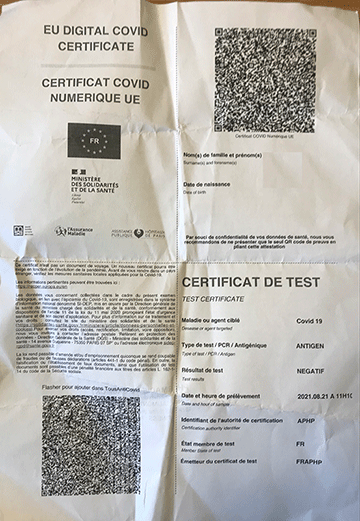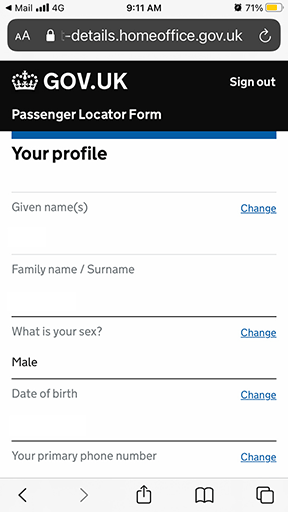After a month in Europe, Nick Stark takes a look at the entry requirements of the continent’s ‘Big Four’
ALTHOUGH global travel in the age of Covid has become far easier since the widespread availability of vaccines, the patchwork of national laws and requirements still make a multi-country trip a challenge.
Having just returned from a four-country jaunt to Europe it seems useful to give a place-by-place guide to the continent’s four most popular destinations: the UK, Italy, Spain and France.
I started my trip in late July flying from LAX to Rome. I was booked onto American Airlines who have outsourced their paperwork requirements to an app company called Verifly. The company blurb claims their product is the industry’s ‘most widely adopted health passport’, although all that really seems to mean is that you can use it on American and their partner airlines, Aer Lingus, Alaska Airlines, British Airways, Iberia, Japan Air Lines, and Qantas. To be fair their interface was simple and required a copy of my vaccination certificate, a negative Covid test taken not more than 24 hours before arrival in Rome, and a completed digital passenger locator form, the EU-wide standard which gave the authorities a way to find you if it was discovered you had been exposed. The system worked well in that at check in I simply had to show the app with its completed ‘ready for travel’ section bearing a photo of myself. My only gripe is that the description of me was a generic ‘confident traveler’. Seems like that was written by a nine year old.

Arriving at Rome was simply a matter of going through passport control. Since the flight was a ‘Covid flight’, the Italian authorities trusted the airline to do all the appropriate screening. The airline, in turn, had delegated it to the app. All in all, a reasonable public private partnership.
Going from Italy to Spain was a different matter. I was arriving by a private sailboat, sailing on a 30-odd hour passage from Sardinia to Menorca. I was required by the Spanish government to complete declaration of being non-symptomatic, upload a copy of my vaccine certificate and provide my location within Spain. This I had to do no earlier than 48 hours before arrival. Simple, right? Not really, because the Spaniards have introduced these requirements without the infrastructure to enforce it. Arriving at Menorca harbor in good time to ‘check in’ with the local customs we found no sign of where the customs building was. When we did find it, we were brusquely informed that we couldn’t tie our boat, even briefly, to the harbor wall in front of the building where we must, by law, present ourselves. We called all the local marinas in the harbor and none of them could accommodate us, not even for an hour or two in a so-called ‘transient berth’, something almost every other harbor I have ever been has at least a few of. So we were forced to drop anchor in the main channel of the harbor and dinghy over to the office. Of course we couldn’t leave our dinghy in front of the office either, we had to tie up half a mile away and walk in 100 degree heat to the office….which was closed. At 2.15pm. A sign outside notified us that their reduced hours were 9am to noon each day. Trouble is, if we returned the following day, we’d be past the 48-hour window for the notification we had completed.
A longtime friend I later visited, who has lived in Spain for 30 years, has a standard response to this kind of everyday frustration; he shrugs his shoulders and mutters ‘that’s Spain’. So that’s what I did. Since my next flight was an internal Spanish one I saw no bad outcome to simply staying in the country until my next departure to Marseilles, in five days.
The French were far more efficient, both in their requirements and their infrastructure. I needed to complete a form online showing my full vaccination status and a passenger locator form so I could be contacted. Into France with no problem for four glorious days staying at a friend’s two hundred year-old stone farmhouse in Provence. When it came time to leave for the UK, I needed to provide a negative Covid test. I was a little concerned that the nearest village, a tiny affair, was too small to provide this quickly, but my fears were unfounded. Their pharmacy was brand spanking new, clean and efficient. Six people were in line in front of me and yet I found myself in the office with my nose being probed in less than ten minutes. The results came out negative about 90 seconds later. I received a QR code for my phone and went on my way for the princely sum of 25 euros. God bless them French

The UK’s requirements were as follows: I needed to show my vaccination certificate, a negative test, a passenger locator form AND a booking for a ‘Day 2 Test’, even though I was leaving for the US on Day 1 (your arrival day is considered Day 0). So I booked a test I would never take, for the not-cheap price of £59, which was to be sent to my hotel to be self-administered. Since I was not going to be there, on the day of my departure for LA I simply went onto the test company’s website and had them re-route the delivery back to their depot for a later pick up. Which will never happen.
So what’s the takeaway from all this? For travellers to Europe, things are still a little confused, a little paperwork heavy and vary in efficiency from place to place. However, at least travel is now possible. And while things were far simpler pre-Covid, given the complexities of modern life, international travel is still comparatively easy. And those international flights? Only one-third to one quarter full, allowing me to stretch out over a complete row for eight hours of uninterrupted sleep, coming and going. So who needs first class?
